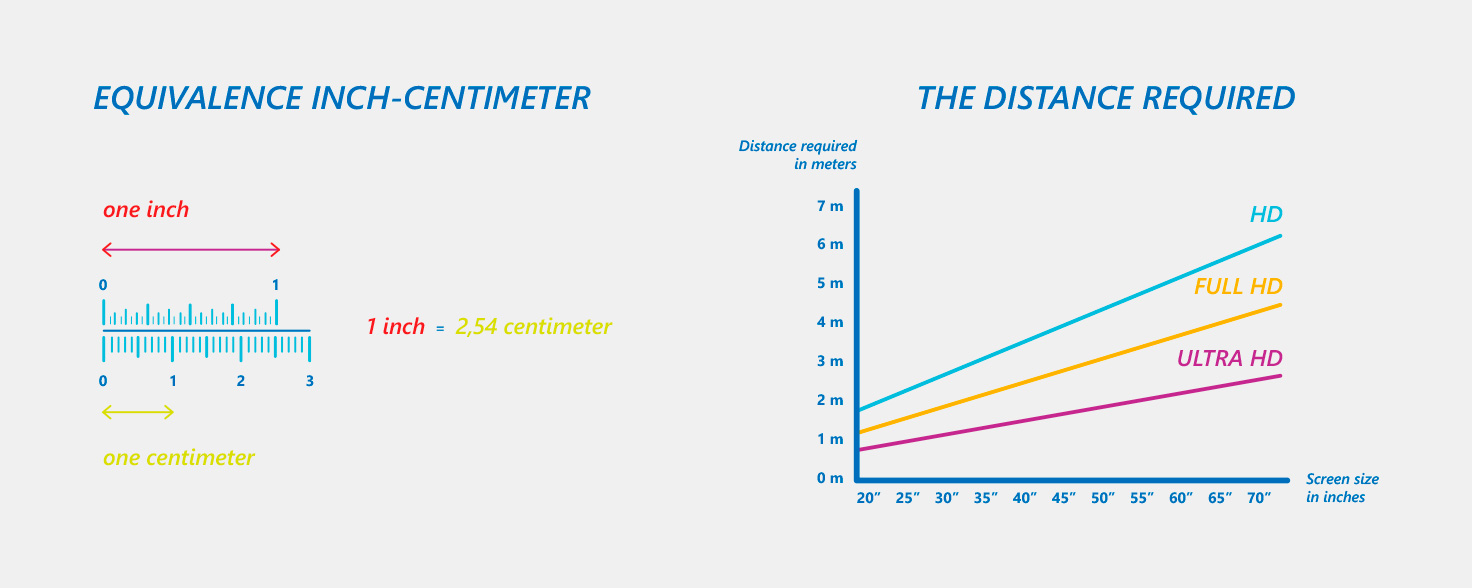1. Sizes and screen resolutions
What size of screen ?
The size of a TV set is measured by the diagonal of the screen, in centimeters (or inches). Thus, a “43-inch TV” is a 110 cm diagonal TV. As a reminder, 1 inch is equal to 2.54 cm. This information will allow you to estimate the distance required to properly install your TV.
How far from the TV set should you be?
- If you are wondering about the viewing distance in order to select a big screen TV, already with High definition, and especially now with the Ultra High definition, the accuracy and detail of images are such that you can watch TV while being close of the screen.
- The distance required is 3 times the diagonal of the screen for an HD TV set, but only 1.5 times for an Ultra HD (or 4K) TV set. For example, for a 125 cm (49 inch) TV set, the minimum required viewing distance is only about 1.8 meters.

With an Ultra HD / 4K screen, we need 2 times less viewing distance: Therefore, why not think really BIG?
Which screen resolution : HD or Ultra HD ?
- The image on the TV is made up of millions of points, the pixels. The resolution (or definition of the image) is this number of pixels. The more pixels there are, the richer will be the image in details and closer to reality.
- If you want the best picture quality available, 4K or UHD (Ultra High Definition) would offer you, four times more pixels than Full HD, more precise details, and immersion into an image closer to real life.
A 4K TV ?
More and more content in 4K will soon be available (streaming, sports games, Youtube, …), and in the meantime, an image processing technology (“upscaling”) can improve the quality of HD images to make them very close to UHD when viewed on a 4K TV.
Why not trade your current HDTV for an Ultra HD / 4K model, with a larger screen than before, and enjoy the ultimate immersion and picture quality?
2. Fluidité et contraste de l’image / TV Connectée
A more fluid and more contrasted picture
If you like watching action movies and sports on TV, nothing is more annoying than a jerky image! To avoid this problem, choose a TV with at least a frequency of 100Hz. The frequency (or refresh rate of the image) is the number of frames per second that the TV shows (1 Hz = 1 frame per second). The higher the frequency, the more fluid and less jittery the image will be.
- For a comparison between different models, it is recommended to use the values of 50, 100 and 200 Hz. Higher values are possible thanks to technologies that artificially increase the number of images perceived by the human eye in order to further improve fluidity.
- High Dynamic Range (HDR) image processing allows for a more contrasted and thus more natural image.
Connected TV or “Smart” TV ?
- Like your computer, tablet or smartphone, some TVs can be connected to the Internet, with an interface, games and various applications (Skype, YouTube, social networks …).
- If you like to give your opinion on a sports game or match, comment it “Live” directly on your Smart TV by connecting to social networks.
- Some TVs have built-in Internet browsers or not, and, in order to use Skype, some have built-in cameras.
- This type of TV connects to the Internet via an Ethernet cable connected to the box, or via Wi-Fi (integrated or optional) or CPL (Data Carrier over Electrical Power Lines).
- A TV with a powerful processor makes it possible to use the Smart TV functions without being slowed down.
3. Sound, Design and Connectivity
Sound
Depending on your needs, to immerse yourself even more in your programs, if you are a fan of movies, TV shows, sports and video games, and to enjoy a rich and powerful sound, why not opt for a soundbar, a Home-Cinema or dedicated speakers?
Design
More and more high-quality TV screens, with more elaborate finishes … This is the design of today’s TVs. For the decor of your home, the appearance of your screen will undoubtedly be a criterion that will also count in the choice of your TV.
Connectivity
Depending on the connection of your equipment, prefer in priority order:
- Digital connectors:
– HDMI: for both sound and picture, in high definition.
– YUV: or video only, if HDMI is not available;
– Optical (to be preferred) or coaxial: for audio - Analog connectors:
– RCA: stereo, except if optical / coaxial jack.
– SCART (SCART): the connector of sound and image of old devices… - Other connectors:
– Headphone: in order not to disturb your loved ones.
– USB: to play media content from USB stick or hard disk drive
– USB+PVR: to save and play programs on USB stick or hard drive
– Memory card reader: to view photos
– PC VGA input: to display content from your PC screen onto your TV set
– Ethernet network (RJ45): to connect your TV set to the Internet
– DLNA: Wireline sharing of content between peripheral devices - Share in Wifi:
– Wi-Fi: to connect your TV set to the Internet by connecting it to the Wi-fi box (as with a computer or tablet).
– Direct Wi-Fi: to connect your mobile devices to your TV set without using Internet or your local network.
– Miracast: to display on your TV set the content of a compatible mobile / tablet.
– NFC: to connect a compatible mobile device to your TV set by bringing them closer to each other.
– DLNA: Wireless home network: Sharing files between compatible devices.

